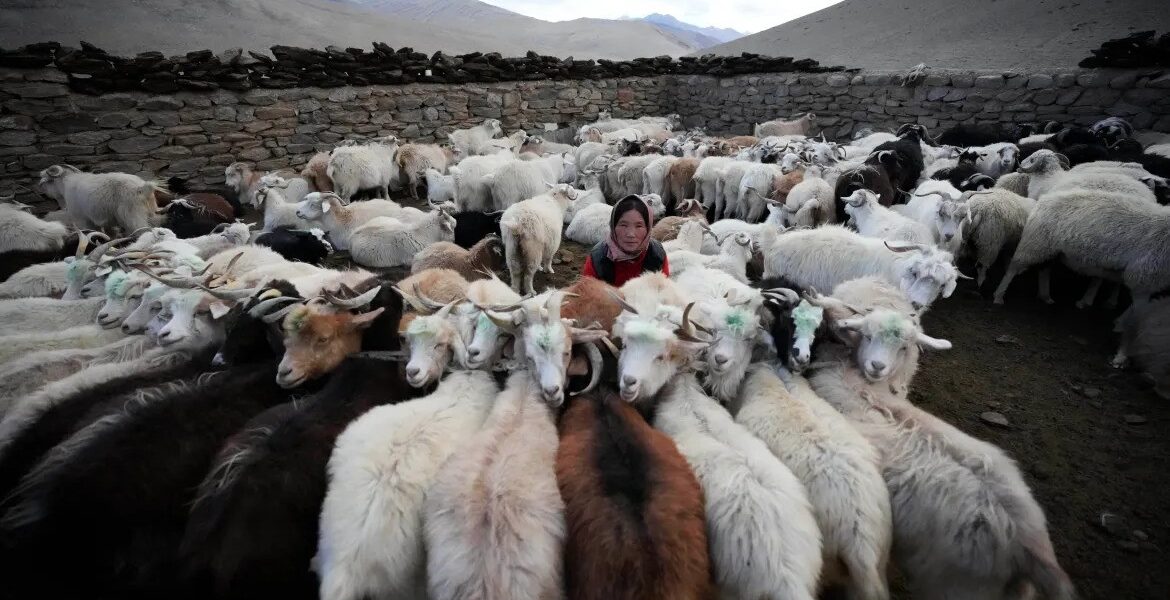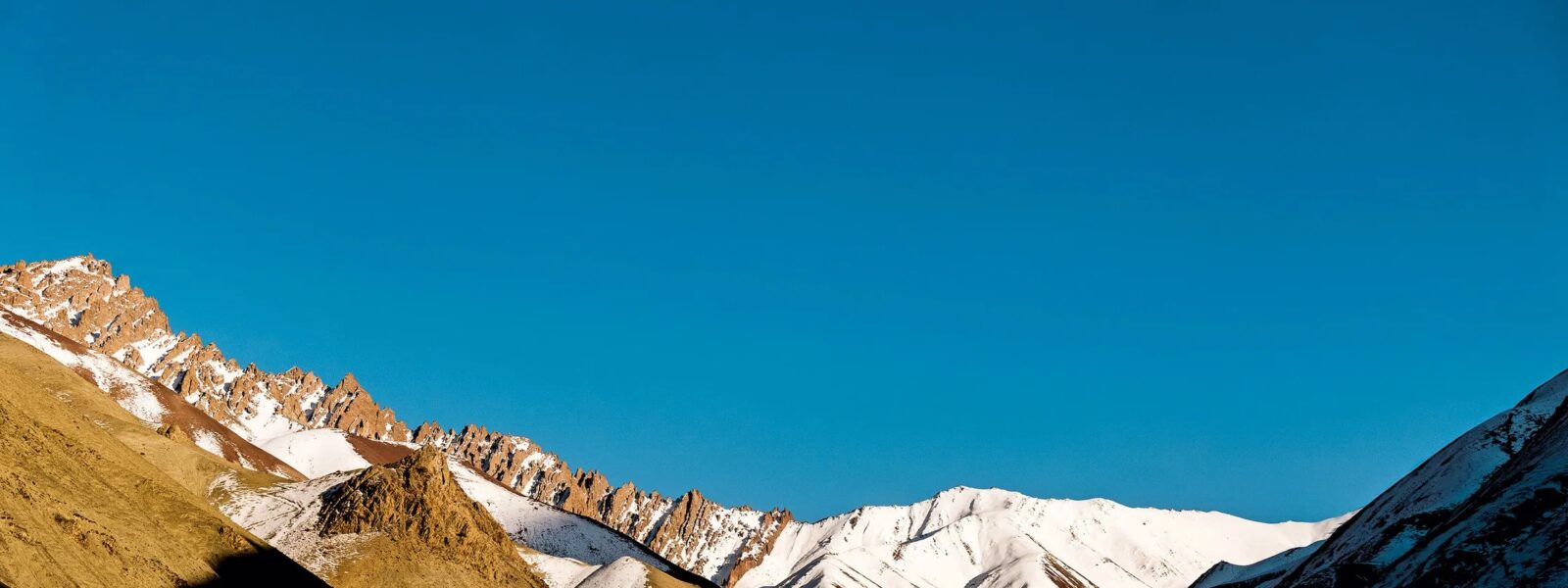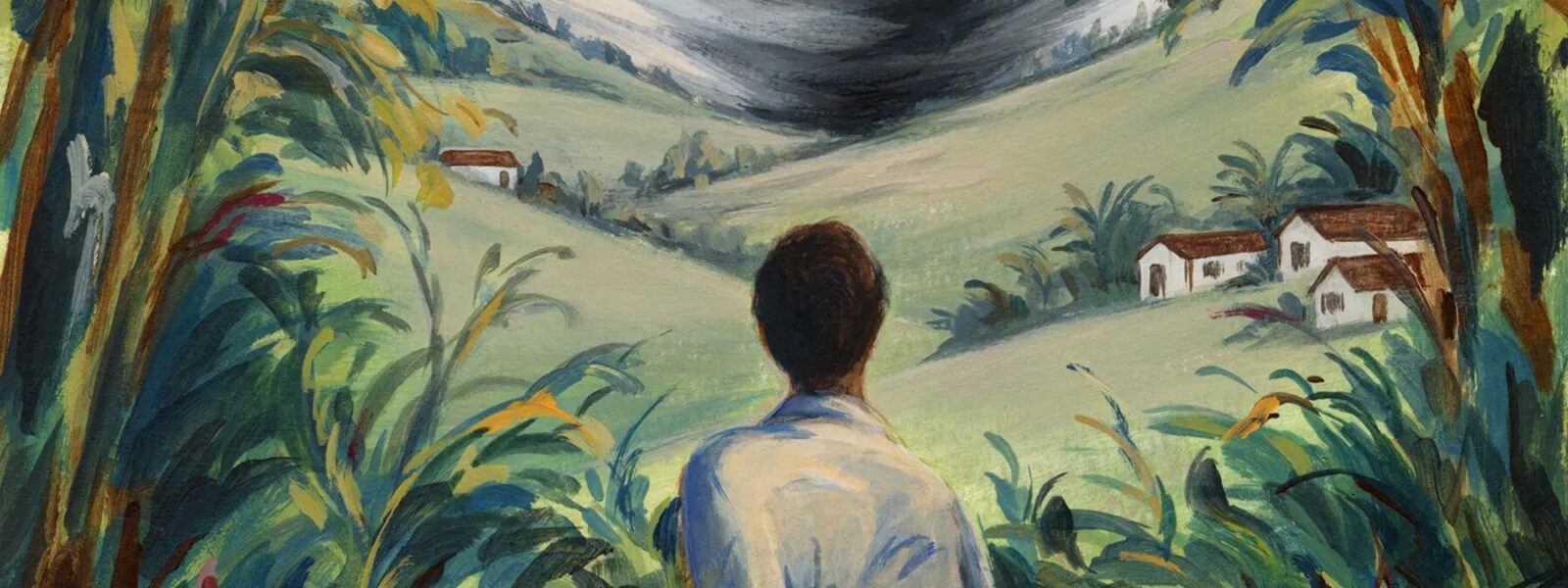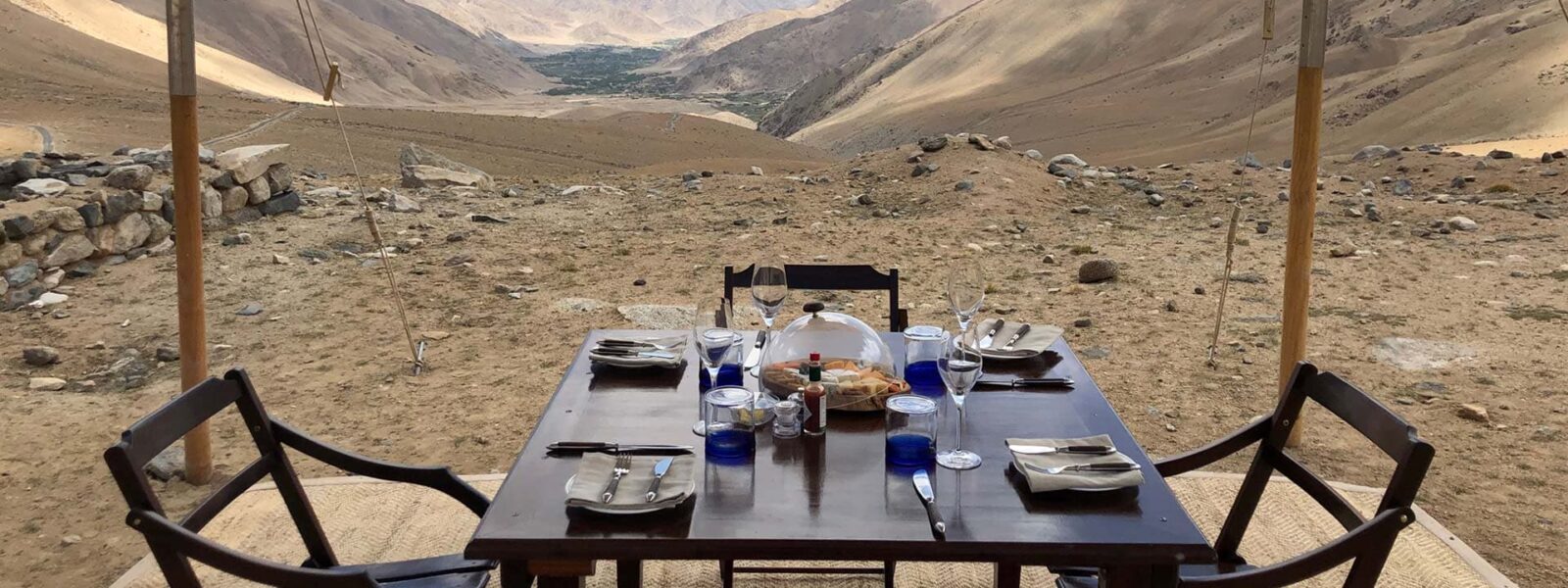Introduction
Tucked deep in the folds of the Indian Himalayas, where rugged peaks embrace the clouds and the air hums with silence, lies a forgotten valley steeped in spiritual tradition and timeless wonder. Welcome to Zanskar — a land of prayer wheels and palace ruins, of chanting monks and forgotten queens. Here, among wind-carved canyons and prayer-flag-fluttered passes, stand three sentinels of sacred heritage: Karsha, Stongdey, and Zangla.
These aren’t just stops on a travel itinerary — they are living repositories of the Buddhist legacy that has shaped this region for centuries. Each monastery and fortress whispers stories of devotion, resilience, and forgotten rule. For the discerning traveler or the culturally curious wanderer, they offer a glimpse into a world where time slows, tradition breathes, and the soul finds space to wander.
Why write about Karsha, Stongdey, and Zangla? Because these places are more than scenic or spiritual; they are the heartbeats of Zanskar’s cultural landscape. In a time when much of the Himalayas is succumbing to over-tourism and rapid development, Zanskar remains remote, authentic, and gloriously untouched — but perhaps not for long.
The road to Zanskar has long been an odyssey in itself, winding through high passes like Penzi La, tracing the path of the Zanskar River, and dipping into isolated valleys where few venture. As new roads arrive and the barriers of remoteness fall, this is the moment to explore the region before the whispers of solitude turn to chatter.
This guide is for those who seek more than a destination. It’s for travelers who want to understand how Zanskar’s Buddhist monasteries continue to shape daily life, how Karsha Monastery remains a pillar of spiritual continuity, how Stongdey balances precariously above a silent valley like a jewel on a cliff, and how Zangla Palace holds echoes of royalty and rebellion.
In the sections that follow, we will explore each of these sacred sites in depth. You’ll find practical tips, rich storytelling, and cultural context that turns mere sightseeing into meaningful exploration. This isn’t just a trip — it’s a step into the sacred.
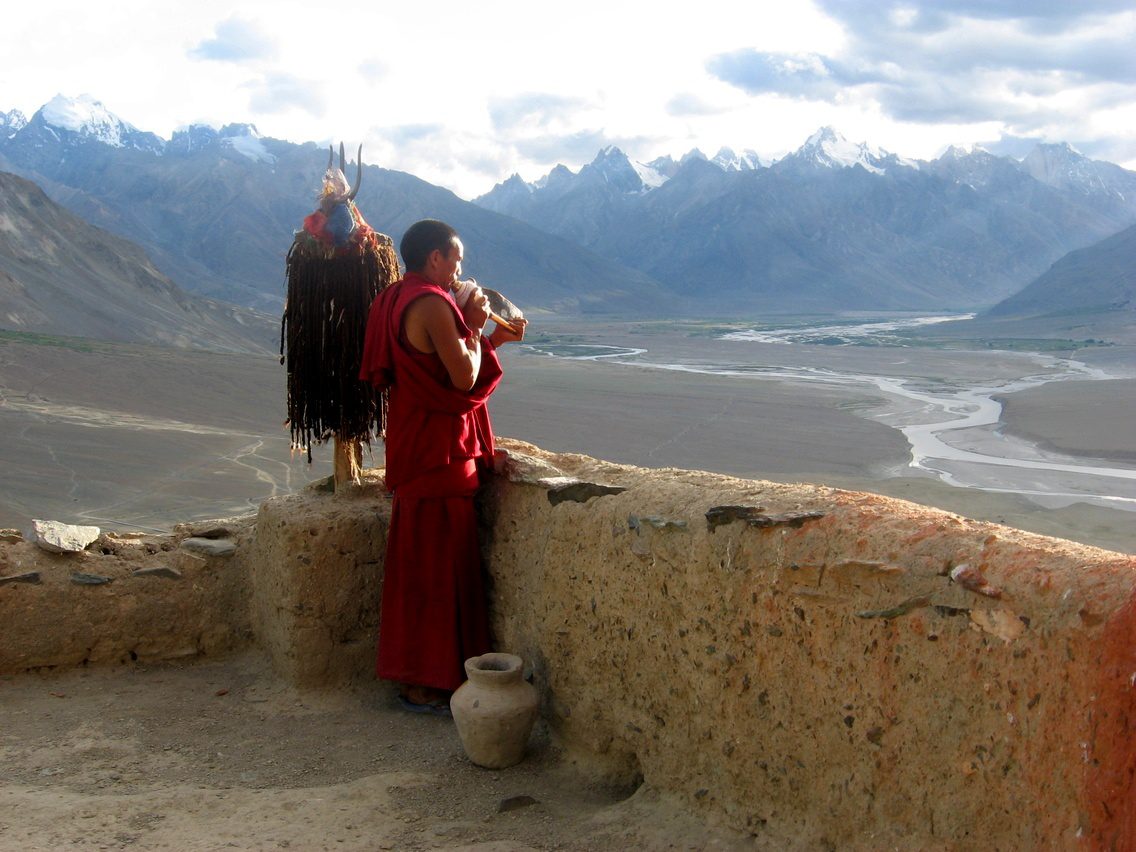
What Makes Zanskar Valley So Special?
In a country bursting with sacred places, high mountains, and ancient cultures, what sets Zanskar apart? The answer lies in its rare fusion of raw nature, spiritual depth, and profound solitude. The Zanskar Valley isn’t simply remote — it’s elemental. The winds here speak in silence, the mountains move in shadow, and time itself seems to have slowed, resting in meditation.
Geographically, Zanskar is one of the most isolated regions in India. Surrounded by towering ranges — the Zanskar and Great Himalayas — it’s tucked between Ladakh to the north and Himachal Pradesh to the south. For much of the year, the valley remains cut off by snow, with only the bravest winter adventurers daring the Chadar Trek across its frozen river. But come summer, its narrow roads open to reveal a forgotten world.
Unlike other parts of Ladakh, Zanskar has preserved its monastic life almost undisturbed. Here, the gompas — Tibetan Buddhist monasteries — are not just museums or tourist stops. They are vibrant spiritual communities. Monks chant prayers that echo through stone halls; young novices carry butter lamps through winding corridors; ancient frescoes fade slowly under the sun’s gaze.
This preservation of tradition isn’t accidental — it’s geographical. Zanskar’s inaccessibility has shielded it from waves of commercialization. And while this has limited economic development, it has protected something even more valuable: authenticity.
What also makes Zanskar extraordinary is its sense of resilience. The people here have learned to thrive in one of the world’s harshest climates, living at altitudes over 3,500 meters, enduring winters that test the soul, and relying on a deep-rooted connection to their land, culture, and faith.
Travelers who venture here don’t just cross landscapes — they cross into a different pace of life. You’ll walk through barley fields irrigated by glacial meltwater, hear prayer flags crack in the mountain wind, and sit with monks whose eyes reflect centuries of wisdom. It’s a place where modern noise hasn’t yet drowned out the ancient pulse.
For those seeking immersive experiences, cultural tourism in Zanskar is not about curated performances or made-for-Instagram moments. It’s about quietly sharing space in a monastery’s prayer hall, tasting tsampa with a host family, or hiking alone on a trail where only snow leopards might be watching.
In Zanskar, you don’t just visit history — you feel it. And that is what makes this valley not only special, but sacred.
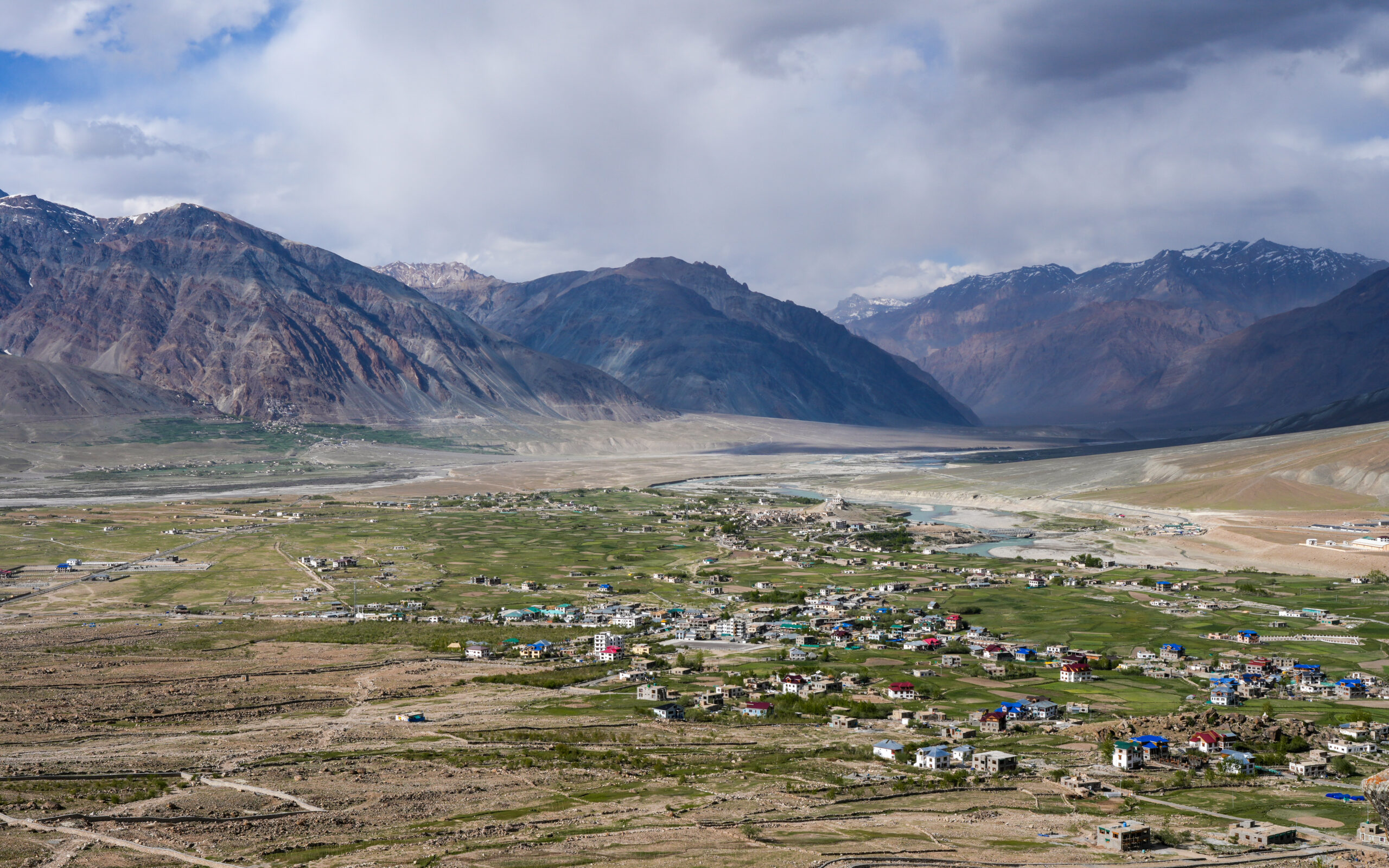
Karsha Monastery: Zanskar’s Largest Gompa
Perched dramatically on a hillside overlooking the wide, flat expanse of the Stod River, Karsha Monastery is the spiritual anchor of Zanskar. It’s the largest and most influential monastic institution in the valley — and when seen from a distance, with its tiered white walls cascading down the mountain like a frozen waterfall, it is nothing short of breathtaking.
Founded in the 10th or 11th century, Karsha is affiliated with the Gelugpa (Yellow Hat) school of Tibetan Buddhism and houses nearly 150 monks. This is not merely a historical site — it’s a living, breathing community where centuries-old rituals unfold every day. When you enter its prayer halls, you walk into spaces rich with incense, the low drone of chanting, and thangka paintings faded by time but glowing with purpose.
Climbing through the narrow passageways and up steep staircases, you’ll discover hidden chapels, towering statues of Avalokiteshvara, and windows that frame the vast Zanskar landscape like silent paintings. On a clear day, the views are endless. In winter, the silence becomes even deeper, as if the monastery and the mountains around it are holding their breath together.
Karsha is also home to one of the most important annual events in Zanskar: the Karsha Gustor Festival, usually held in July. During this two-day festival, the monastery bursts into color, music, and rhythm. Masked cham dancers whirl in symbolic reenactments of good overcoming evil, while villagers from around the valley gather in their finest traditional clothing. It’s both a deeply religious ceremony and a rare moment of communal celebration in this otherwise quiet land.
One of the most unforgettable aspects of visiting Karsha is the humility of its setting. There’s no grand entrance, no tourist signage, no ticket counter. You arrive by walking — either on foot from the town of Padum, or via a narrow dirt road — and you’re greeted by silence and wind. The monks may offer tea if you linger, or they may simply nod and return to their mantras. Either way, you are welcomed into something sacred.
Practical travelers should note that Karsha is just a few kilometers from Padum, making it an ideal day excursion or an extended cultural visit. If you’re trekking through Zanskar or planning a spiritual circuit, Karsha deserves more than just a passing glance — it deserves reverence.
For those seeking more than a destination, Karsha is a revelation. It is where time folds inward, where stone and soul merge, and where the whisper of the Himalayas speaks loudest through silence.
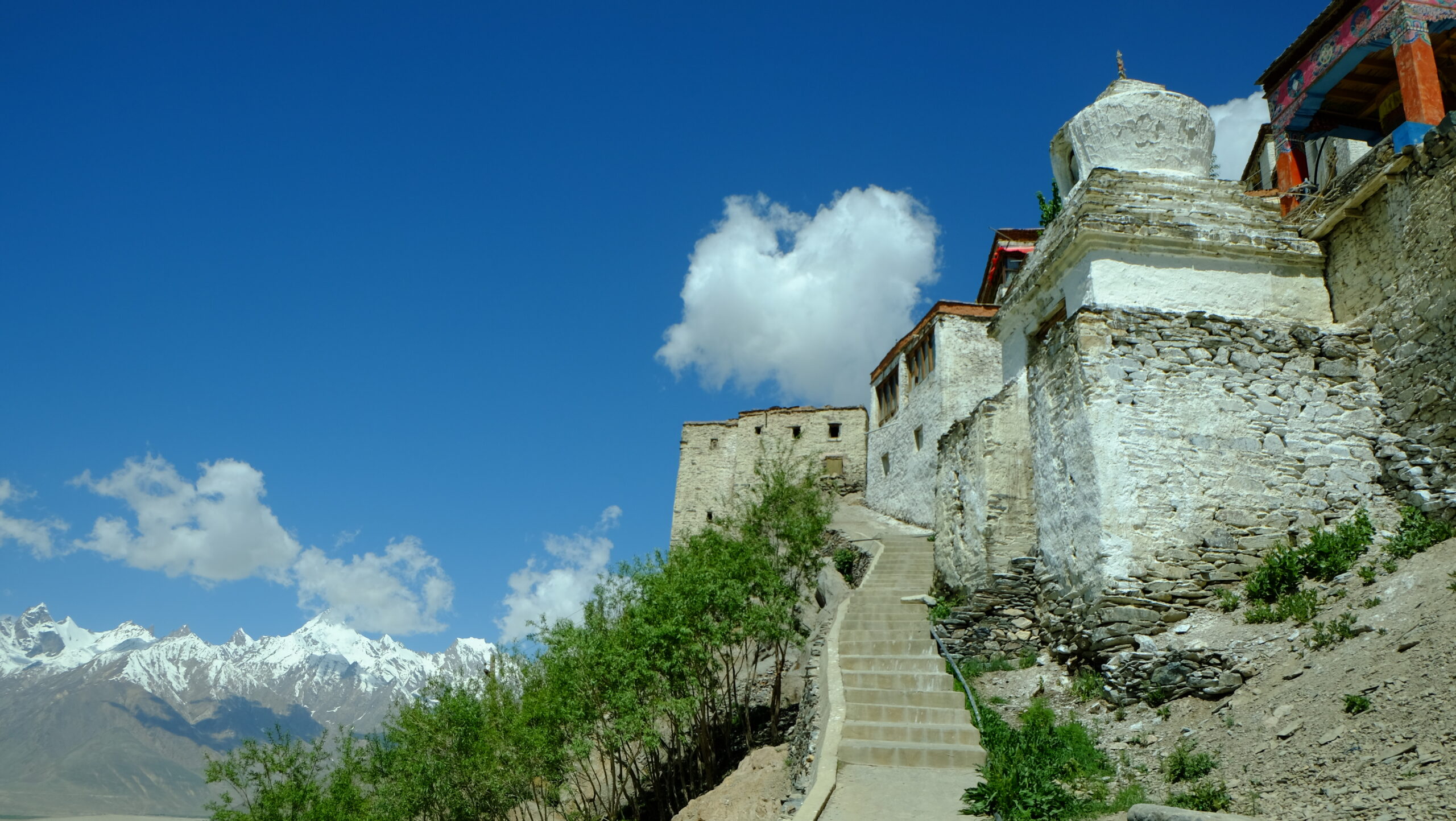
Stongdey Monastery: High Above the Clouds
If Karsha is Zanskar’s spiritual heart, then Stongdey Monastery is its soul perched in the sky. Located approximately 18 kilometers from Padum, this hilltop gompa clings to the edge of a craggy cliff like a guardian of the valley below. From its elevated vantage point, it offers panoramic views of the golden barley fields, the glinting Zanskar River, and the majestic peaks that encircle the region in timeless silence.
Founded in the 11th century by the famed Tibetan scholar Marpa Lotsawa, Stongdey Monastery belongs to the Drugpa (Drukpa) lineage of Tibetan Buddhism — a sect known for its emphasis on direct experience and spiritual discipline. Home to around 60 monks, it is the second largest monastery in Zanskar and remains a vital center of spiritual practice, religious education, and sacred art.
The approach to Stongdey is both dramatic and serene. A narrow, winding road ascends through dry, windswept slopes, and as you climb, the whitewashed monastery comes into view, glowing like an apparition against the ochre cliffs. Unlike many gompas overwhelmed by visitors, here you may still find yourself alone in a prayer hall, accompanied only by flickering butter lamps and the low hum of recitation.
Inside the monastery complex are seven chapels, each offering something distinct: intricately painted mandalas, statues of Padmasambhava and Avalokiteshvara, and centuries-old scriptures inscribed on handmade paper. One of the most striking aspects is the vibrant wall paintings — untouched by mass tourism, they retain a raw, unfiltered beauty. The murals in the Dukhang (main assembly hall) are especially moving, narrating the lives of Buddhist masters and celestial protectors.
Stongdey also hosts an annual festival in the eleventh Tibetan month, usually falling in early winter. During this time, masked dancers perform sacred cham rituals, and the valley — otherwise quiet — echoes with the sound of long horns, drumbeats, and communal celebration.
For photographers, early morning at Stongdey is pure magic. The rising sun illuminates the mountains and the monastery with a soft golden hue, prayer flags ripple in the breeze, and the silence feels ancient. For trekkers, it can be part of a cultural circuit, connecting Karsha, Zangla, and other lesser-known gompas through narrow paths used by villagers and monks for generations.
Despite its grandeur, Stongdey is a place of humility. Its monks live modestly, its doors are always open, and its spiritual energy is felt in every step. You won’t find souvenir shops or cafés here — just sky, stone, and a profound stillness that stays with you long after you’ve left.
Visiting Stongdey is not about ticking off a destination. It is about climbing toward silence, standing above the world, and remembering how small yet connected we all are under the wide Himalayan sky.
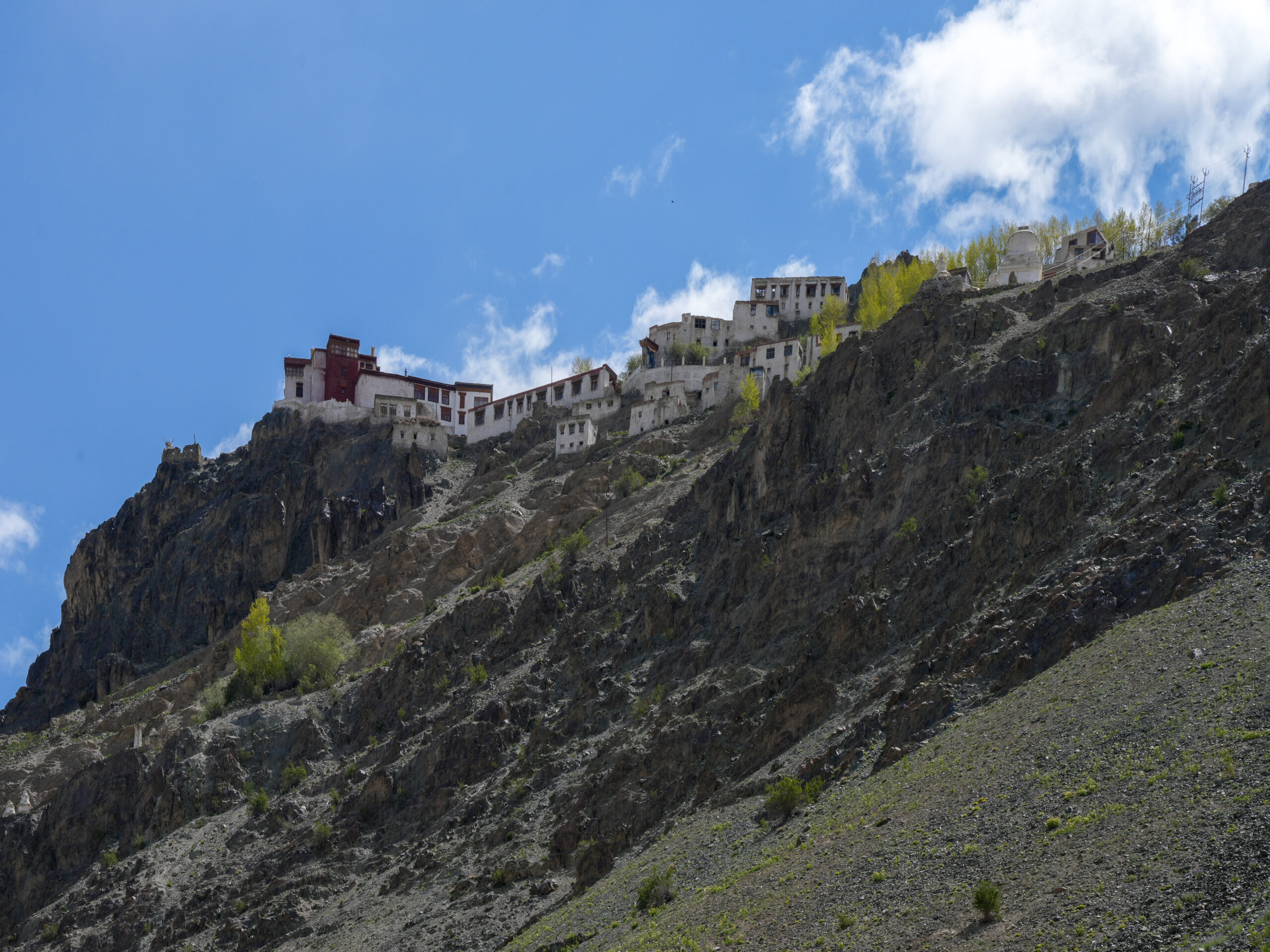
Zangla Palace: Remnants of a Forgotten Kingdom
Zanskar is not only the land of monks and monasteries — it is also a land of forgotten royalty. Nowhere is this more vividly felt than in Zangla Palace, a crumbling fortress of stone and memory perched above the quiet village of Zangla. Though time has worn away its grandeur, this lonely structure whispers tales of a bygone kingdom, of rulers and rebellions, and of a queen who once hosted one of the most legendary women explorers of the 20th century.
Located about 35 kilometers from Padum, Zangla is at the far edge of the valley’s inhabited zone. The village itself is modest — a handful of homes, terraced fields, a school, and a new monastery — but above it, the remains of the palace loom like a sentinel. The palace is thought to date back to the 17th century and once served as the seat of a minor Zanskari dynasty that governed this remote corner of the kingdom.
The most famous chapter in Zangla’s history unfolded in 1912, when Alexandra David-Néel, the French-Belgian explorer and Buddhist scholar, stayed here during her groundbreaking journey into the heart of Tibet. She lived in the palace as a guest of the royal family for several months, studying Tibetan texts and learning from the monks of the nearby monastery. Her memoirs recount not only the hospitality she received, but the palace’s chilly stone corridors, flickering butter lamps, and the sense of standing on the edge of the known world.
Today, the palace is largely in ruins. Its wooden beams creak in the wind, and some rooms have collapsed, leaving only shadows and silence. Yet there’s still a small prayer room in use, and villagers occasionally climb the hill to make offerings or seek moments of solitude. The site offers one of the finest panoramic views in Zanskar — from the palace walls, you can see the entire valley unfurl like a map below, with barley fields, fluttering flags, and white-washed chortens dotting the landscape.
For the culturally curious, Zangla represents a rare convergence: a site that blends political history, spiritual continuity, and architectural decay into a living narrative. It stands apart from the religious focus of Karsha and Stongdey. Here, the stories are about lineage, power, exile, and survival. It offers a crucial reminder that Zanskar was not just a monastic refuge — it was a functioning society with rulers, subjects, and worldly affairs.
The best way to reach Zangla is via road from Padum. A full-day excursion allows time to explore the village, the palace, and even visit the nearby Zangla nunnery or take a short walk to ancient cave hermitages scattered in the hills beyond. In recent years, efforts have been made to stabilize parts of the structure, though the overall feel remains raw and untouched.
Zangla Palace doesn’t offer the vibrant chants of a monastery or the meticulous detail of restored murals. Instead, it offers space — for reflection, for memory, and for understanding how faith, royalty, and survival once intertwined on this high Himalayan frontier. It is a place where history lingers in the stones and where silence speaks with the weight of centuries.
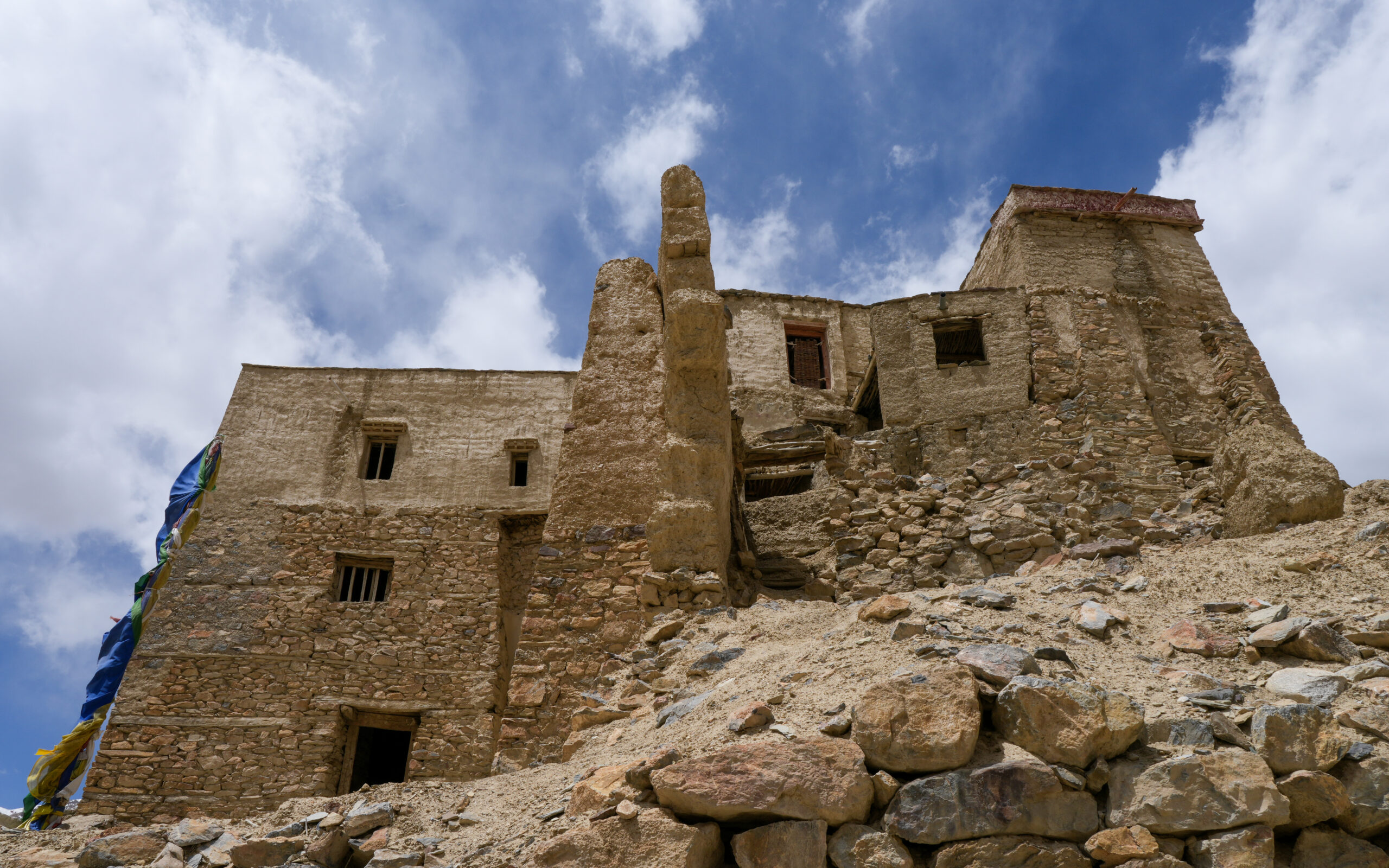
Best Ways to Reach the Zanskar Monasteries
Zanskar is not a place you stumble upon — it’s a destination you earn. Reaching its sacred monasteries and ancient palaces requires determination, planning, and a sense of adventure. But that journey, often rugged and unpredictable, is precisely what makes the experience unforgettable. Getting to Karsha, Stongdey, and Zangla is not just about transportation; it’s about stepping off the grid and into the high-altitude heart of the Himalayas.
For most travelers, the gateway to Zanskar is Padum, the administrative and cultural center of the valley. Until recently, Padum could only be reached by traversing high mountain passes like Pensi La from Kargil — a two-day journey that included basic accommodations and narrow dirt tracks flanked by sheer cliffs. However, recent infrastructure developments have started to open new routes from Darcha (in Himachal Pradesh) via Shinku La, making access somewhat easier in the summer months.
The road from Kargil to Padum remains the most popular and scenic option. It passes through the majestic Suru Valley, crosses the dramatic Pensi La (4,400 meters), and skirts along the shimmering Drang Drung Glacier before descending into Zanskar. This route is only open between June and October due to heavy snowfall and landslide risks in the colder months.
Once in Padum, each monastery is a short journey away. Karsha Monastery lies just 9 kilometers from the town center, accessible by a narrow road or on foot. A morning hike to Karsha is a rewarding way to begin your immersion into the region’s spiritual landscape. The path winds through barley fields and crosses a footbridge over the Zanskar River, with yaks and villagers offering the only company.
Stongdey Monastery is about 18 kilometers northeast of Padum, perched atop a rugged hill. Hiring a local taxi or arranging a private vehicle is the most practical way to reach it, especially for sunrise or sunset views. Adventurous travelers may choose to bike or trek part of the route, enjoying the dramatic shift in elevation and the changing landscape.
Zangla Palace, the furthest of the three sites, is situated around 35 kilometers from Padum. The road to Zangla passes through sparse villages and vast plateaus, gradually narrowing as it approaches the palace’s elevated viewpoint. The journey here is not just about history — it’s about isolation. Make sure your vehicle is in good condition, and carry extra water, snacks, and perhaps even fuel if you’re venturing in early or late season.
While public transportation within Zanskar is limited, it’s possible to arrange jeeps or shared taxis through guesthouses and local travel agencies. Some adventurous travelers prefer to rent motorbikes in Leh and ride all the way to Zanskar, although this requires experience with Himalayan terrain and high-altitude riding.
Regardless of how you choose to travel, remember: in Zanskar, the journey is as sacred as the destination. Allow yourself time. Roads may close due to landslides, bridges may be washed out, and local festivals or rituals may cause delays. But that’s part of the rhythm here — slow, unpredictable, and full of wonder. To travel to Zanskar is to let go of rush and rediscover the joy of the road less traveled.
Cultural Immersion: Festivals and Monastic Life
Zanskar is not merely a destination to be seen — it’s a world to be felt. Behind the whitewashed monastery walls and crumbling palace stones lies a deeply rooted way of life, shaped by high-altitude hardship and unwavering spiritual devotion. To understand the valley, one must go beyond photography and step into the rhythm of monastic life and local celebration.
Throughout the year, the monasteries of Karsha, Stongdey, and even the quiet hamlets surrounding Zangla come alive with sacred rituals and festivals that offer a glimpse into a worldview shaped by compassion, meditation, and cosmic balance. One of the most significant events is the Karsha Gustor Festival, held annually in summer. During this two-day celebration, the usually silent courtyards of Karsha Monastery burst into movement as masked monks perform sacred cham dances, symbolizing the triumph of good over evil.
The air fills with the deep drone of dungchen horns, the rhythmic beat of drums, and the sweet scent of burning juniper. Each mask, dance step, and gesture has meaning — a living language of spirituality passed down through generations. Villagers walk for hours to attend, dressed in their finest woolen robes and turquoise-studded jewelry, turning the monastery into a space not just of worship but of vibrant community.
Though less publicized, Stongdey Monastery also hosts an important festival during the eleventh Tibetan month. Its remoteness makes the gathering smaller, more intimate — and for many travelers, even more powerful. Witnessing such a ritual here, with the valley spread out below and prayer flags fluttering wildly in the wind, feels like standing inside a dream.
But festivals are just the visible surface of monastic life in Zanskar. To truly connect, travelers must slow down. Rise early and walk quietly through the monastery corridors. You might see young novices in maroon robes reciting morning prayers or elders meticulously painting new thangka scrolls in ancient technique. In kitchens, monks stir pots of butter tea over open flames, sharing laughter and silence in equal measure.
If you’re fortunate — and respectful — you may be invited to sit in on a puja (prayer ceremony). These experiences are not about spectacle but about presence. You listen, you watch, you breathe in the incense, and without realizing it, you begin to align with the stillness that permeates every corner of Zanskar.
For travelers looking to go deeper, homestays in nearby villages offer another layer of cultural immersion. Sharing meals, stories, and simple routines with Zanskari families reveals the quiet strength and warmth of a people who live in close harmony with their environment and traditions. It’s here that you understand why the monasteries exist — not as isolated institutions, but as spiritual hubs woven into the fabric of everyday life.
Zanskar’s monastic culture is not a relic of the past. It is a living, breathing force that continues to shape identity, morality, and meaning in this high Himalayan world. To witness it is a gift. To participate, even briefly, is a transformation.
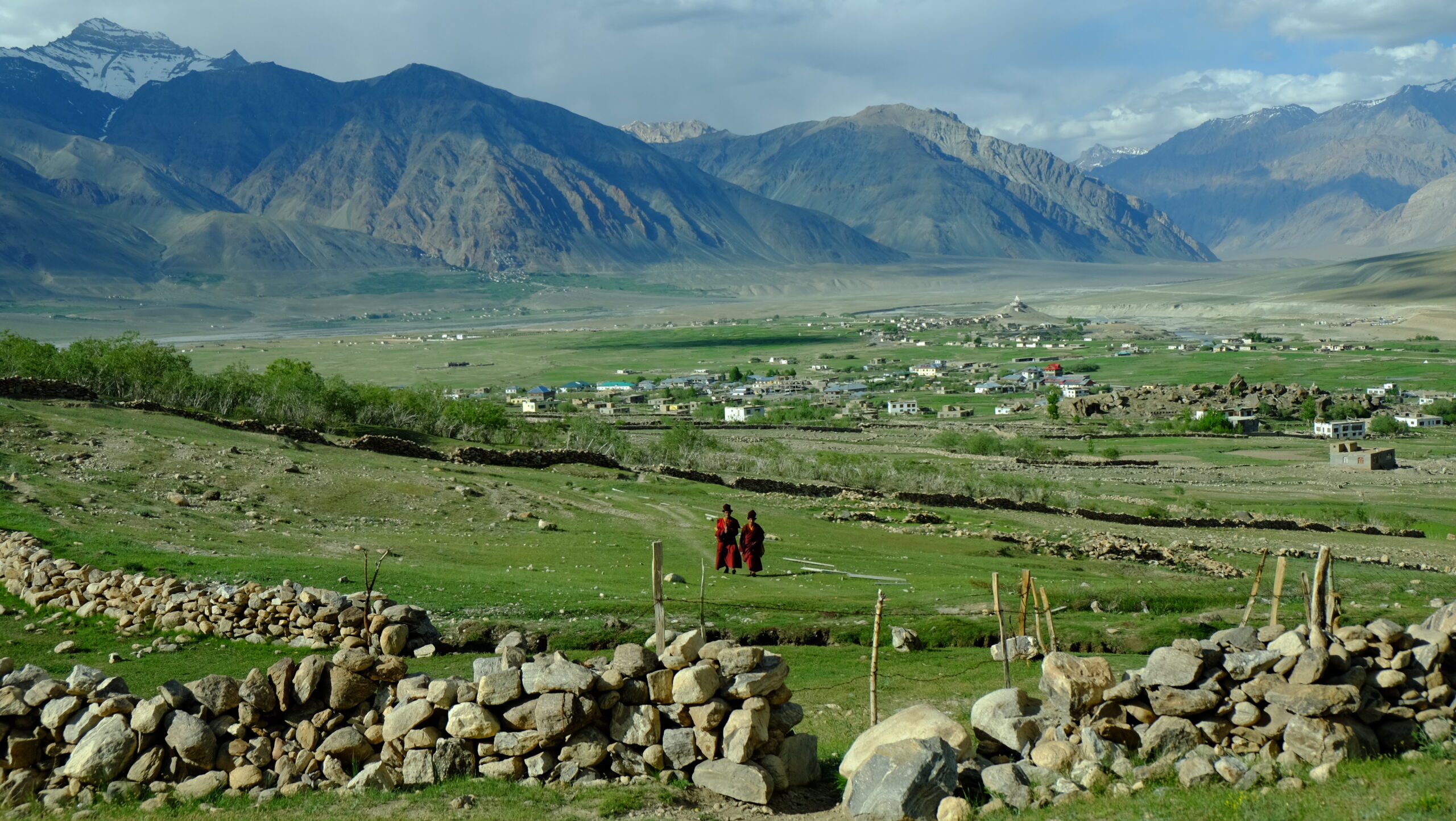
Suggested Itinerary: A Journey Through Zanskar’s Spiritual Trail
Zanskar is a destination that asks for time — not in the rushed sense of ticking off sights, but in the sacred act of slowing down, of walking between places, of being still. For those who want to do more than visit, but truly absorb the spirit of the land, this suggested itinerary weaves together the most profound stops along the monastic heritage trail: Karsha, Stongdey, and Zangla.
Day 1: Arrival in Padum
Begin your journey in Padum, the cultural and logistical hub of Zanskar. Spend the day acclimatizing to the altitude, strolling through the market, and perhaps visiting the small but active Dzong Monastery in the town. Arrange your transportation or trekking support for the days ahead.
Day 2: Karsha Monastery and Village Exploration
A short drive or scenic walk takes you to Karsha Monastery. Arrive early to attend the morning prayers. Wander through the monastery’s intricate halls, pause before the ancient murals, and watch monks go about their day. After lunch, descend into Karsha Village and visit local families or the nearby nunnery. Stay overnight in a homestay for a full cultural experience.
Day 3: Hike or Drive to Stongdey Monastery
Leave early for Stongdey Monastery, situated high above the valley floor. Whether you hike or drive, the views are magnificent. Spend unhurried time with the monks, explore the various chapels, and linger in silence. If you’re up for it, continue trekking along ancient footpaths once used by traders and pilgrims. Return to Padum or camp near Stongdey if conditions allow.
Day 4: Drive to Zangla and Explore the Palace
Set off on the remote road to Zangla Village. The journey itself is part of the magic — a stretch of emptiness and wide skies. Once there, climb to the ruins of Zangla Palace and look out over the valley, imagining the days of royalty and resistance. Visit the nearby Zangla nunnery or make a short trek to ancient meditation caves carved into the cliffs. Overnight in a local guesthouse or return to Padum if timing allows.
Day 5: Optional Trek or Deeper Immersion
Use this day to go deeper — join a morning puja, help with monastery chores, or hike between smaller gompas like Sani, Bardan, or Phugtal (if you’re up for a longer extension). For writers, photographers, and thinkers, Zanskar offers unmatched inspiration. For spiritual seekers, it offers quiet answers in the form of wind, stone, and ritual.
This suggested itinerary is only a template. The real key is flexibility — to let the road guide you, to say yes when a monk invites you for tea, or to pause a day longer when the valley still has something to tell you. In Zanskar, itineraries are more than plans. They are pilgrimages of the soul.

Travel Tips for Exploring Zanskar
Zanskar is not your average travel destination — it’s wild, remote, and spiritually intense. That’s exactly what makes it unforgettable. But to navigate this high-altitude Himalayan world with care and confidence, a little preparation goes a long way. Below are key travel tips to help you journey wisely, safely, and respectfully through this sacred land.
1. Best Time to Visit
The ideal window to explore Zanskar is from June to mid-October. During this period, the mountain passes are open, temperatures are manageable, and village life is in full swing. By mid-October, snowfall begins and roads become impassable. July and August are peak festival months, including the famous Karsha Gustor Festival.
2. Acclimatization and Altitude
Padum sits at an altitude of over 3,500 meters. Give your body time to adjust, especially if you’re coming directly from lower altitudes. Spend a full day resting upon arrival, stay hydrated, and avoid alcohol. Signs of altitude sickness include headache, nausea, and dizziness — take them seriously. Consider carrying medication like Diamox if you’re prone to AMS.
3. Transportation and Road Conditions
The journey to Zanskar can be long and rugged. Whether arriving from Kargil or via Shinku La from Himachal Pradesh, expect narrow, unpaved roads with occasional landslides or delays. Hiring a local driver familiar with the terrain is highly recommended. Shared taxis are available in peak months, but private jeeps allow for greater flexibility and comfort.
4. Accommodation Options
In Padum, you’ll find basic guesthouses with hot water, simple meals, and Wi-Fi (intermittent at best). Outside Padum, especially in Karsha, Stongdey, and Zangla, accommodation is minimal — often in the form of homestays or camping. What you lose in comfort, you gain in connection. Bring a sleeping bag, power bank, and your sense of humility.
5. Cultural Etiquette and Respect
Zanskar is deeply traditional and religious. Always ask permission before taking photos of people, religious rituals, or inside monasteries. Dress modestly — long sleeves and pants are preferred. Remove shoes before entering prayer halls, and speak softly. Gifts such as school supplies or solar lamps are appreciated if you wish to contribute meaningfully.
6. Packing Essentials
The weather can change quickly, so pack layers: thermal innerwear, fleece jackets, windproof shells, and warm hats are essential. Don’t forget sunscreen, sunglasses, lip balm, and a refillable water bottle. Roads are rough — a small first-aid kit, headlamp, and water purification tablets are also useful.
7. Connectivity and Cash
There’s little to no mobile signal once you enter Zanskar — only BSNL works intermittently. Carry all necessary cash in small denominations, as there are no reliable ATMs. Digital payments are rare, and even electricity can be unstable in more remote areas.
8. Responsible Travel
Zanskar is a fragile ecosystem. Minimize waste, avoid plastic bottles, and carry out everything you bring in. Support local businesses, eat locally-sourced food, and respect local pace and customs. Tourism here is still in its early stages — be a part of shaping it responsibly.
With preparation and an open heart, Zanskar will offer you not just a trip, but a transformation. Its silence will speak volumes, its mountains will humble you, and its people will leave you richer than when you arrived.
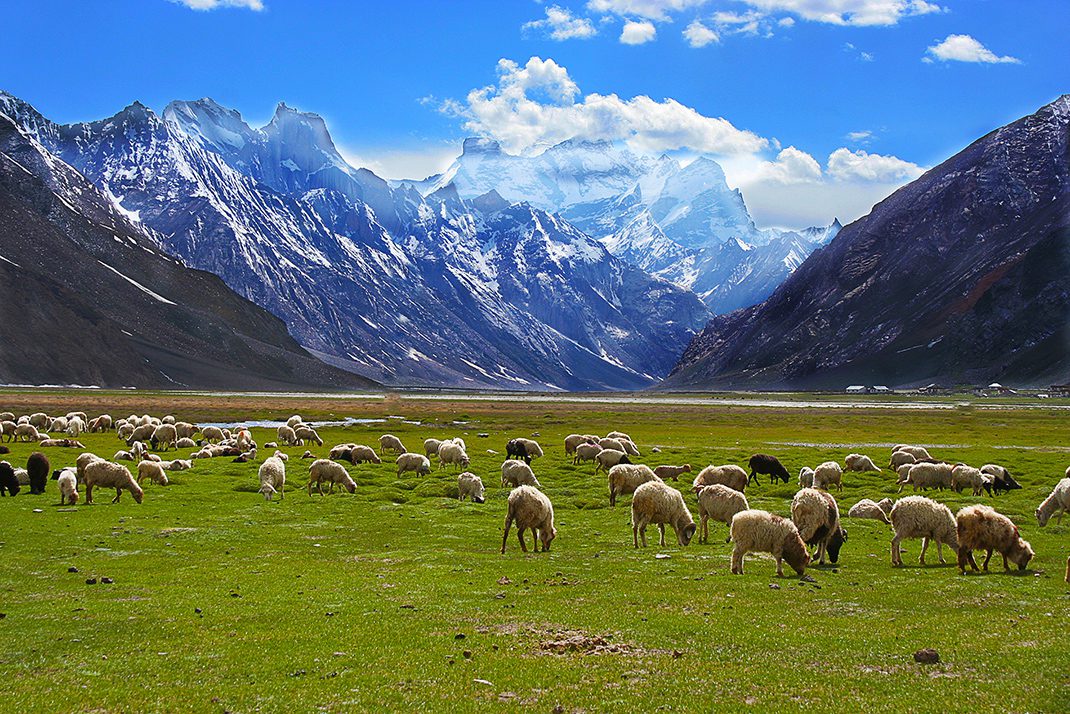
Conclusion: Why Zanskar’s Legacy Matters
In a world spinning faster by the day, there are still places where time slows, breath deepens, and meaning lingers in the stillness. Zanskar is one of those rare places — not a remnant of the past, but a refuge for the soul. Here, amid windswept plateaus and sky-touching peaks, the legacy of Karsha, Stongdey, and Zangla speaks quietly, but powerfully, to those who are ready to listen.
These sites are more than travel destinations. They are living chapters in the long story of Himalayan Buddhism — stories of teachers and kings, hermits and queens, of monks preserving sacred knowledge in remote monasteries while the rest of the world rushed ahead. They are reminders that wisdom doesn’t always wear a digital face, and that peace doesn’t arrive through noise.
To stand in the prayer hall at Karsha, to trace your fingers along the stone corridors of Zangla Palace, or to watch the sunrise from Stongdey is to step out of modernity and into memory. But it’s also to realize how alive these places still are — how their chants, festivals, and traditions pulse in rhythm with the land and its people.
Zanskar’s legacy matters because it shows us another way of being — a way rooted in community, spirituality, and reverence for nature. In the chants of monks, in the patient weaving of a Zanskari grandmother, in the kindness of a stranger sharing butter tea — there is a truth we forget too easily in our cities and screens.
As roads extend and the world arrives, Zanskar will inevitably change. Tourism will grow. But what will remain — if we care for it — is this legacy: a fragile, sacred flame of human spirit, lit in stone and snow. Let us travel not to consume it, but to honor it.
So go. With respect. With curiosity. With gratitude. And may you return not just with photographs, but with a quiet understanding of why Zanskar — and the guardians of its monastic soul — still matter in this ever-changing world.


